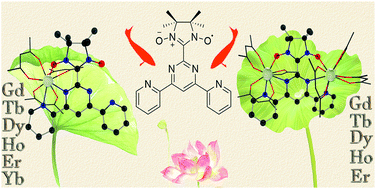A family of lanthanide complexes with a bis-tridentate nitronyl nitroxide radical: syntheses, structures and magnetic properties†
Abstract
Eleven new lanthanide complexes based on a bis-tridentate nitronyl nitroxide radical NIT-Pm2Py (2-(4,6-di(pyridin-2-yl)pyrimidin-2-yl)-4,4,5,5-tetramethyl-4,5-dihydro-1H-imidazol-1-oxy-3-oxide), namely (NIT-Pm2Py)Ln(hfac)3 (Ln = Gd (1Gd), Tb (2Tb), Dy (3Dy), Ho (4Ho), Er (5Er), Yb (6Yb)), [(NIT-Pm2Py)Ln2(hfac)6]·xH2O (Ln = Gd (7Gd), Tb (8Tb), Ho (10Ho), x = 0.5 for 7Gd and 1 for 8Tb and 10Ho) and (NIT-Pm2Py)Ln2(hfac)6 (Ln = Dy (9Dy), Er (11Er)) were prepared and characterized. These complexes can be selectively prepared by controlling the reaction ratio of Ln(hfac)3·2H2O to the radical ligand NIT-Pm2Py. Single crystal X-ray crystallographic analyses confirmed that 1Gd–6Yb are isostructural 2p–4f LnIII–radical complexes, in which the NIT-Pm2Py radical acts as a terminal tridentate ligand chelating to one LnIII ion. On the other hand, 7Gd–11Er are isostructural 4f–2p–4f LnIII–radical–LnIII complexes with the NIT-Pm2Py acting as a bridging ligand between two LnIII ions. 7Gd–11Er represent a rare family of complexes showing the NIT bridged 4f–2p–4f three-spin motif. Alternating-current (ac) magnetic susceptibility investigations revealed that complex 6Yb exhibits field-induced frequency dependence, suggesting a possible field-induced single-molecule magnet behavior. Ab initio calculations were performed on all these complexes. The fitting of the magnetic susceptibilities of these complexes indicates weak antiferromagnetic coupling between the LnIII and NIT radical.



 Please wait while we load your content...
Please wait while we load your content...